Organisational Behaviour and Management of People Report - TESCO
VerifiedAdded on 2020/11/23
|11
|2929
|93
Report
AI Summary
This report delves into the core concepts of organisational behaviour, exploring the dynamics of how individuals behave within an organisation. It defines key terms such as motivation, leadership, and organisational power, drawing upon influential theories from prominent psychologists. The report examines motivational theories, including Maslow's hierarchy of needs and Herzberg's hygiene theory, and their impact on employee behaviour. It further investigates various leadership theories, such as the trait theory and the House path-goal theory. Furthermore, the report analyses the application of these theories within the context of TESCO, providing real-world examples of how the company leverages organisational behaviour principles to enhance employee motivation, leadership effectiveness, and overall organisational performance. The analysis of TESCO illustrates how these theories are practically implemented to create a positive working environment.
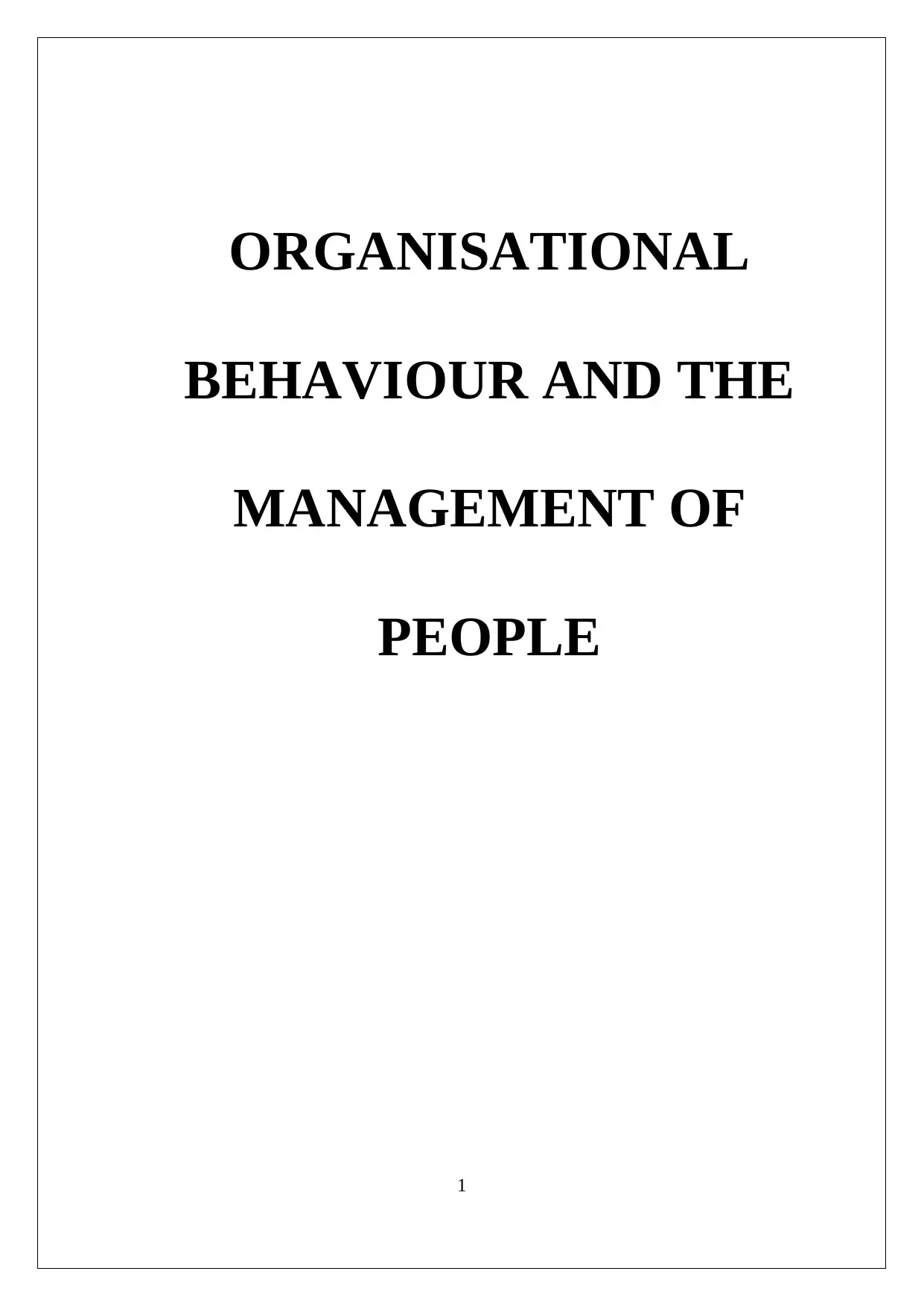
ORGANISATIONAL
BEHAVIOUR AND THE
MANAGEMENT OF
PEOPLE
1
BEHAVIOUR AND THE
MANAGEMENT OF
PEOPLE
1
Paraphrase This Document
Need a fresh take? Get an instant paraphrase of this document with our AI Paraphraser
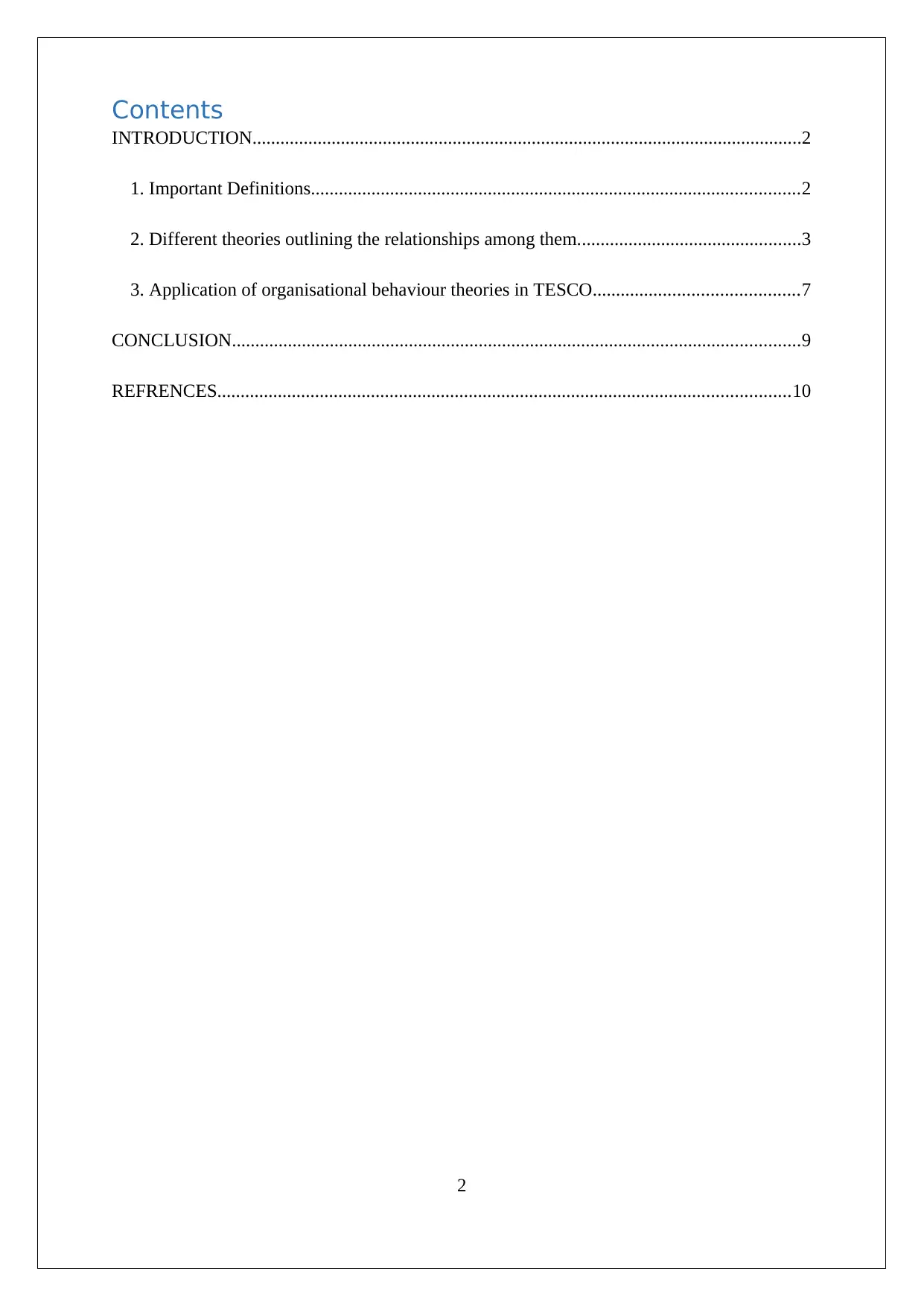
Contents
INTRODUCTION......................................................................................................................2
1. Important Definitions.........................................................................................................2
2. Different theories outlining the relationships among them................................................3
3. Application of organisational behaviour theories in TESCO............................................7
CONCLUSION..........................................................................................................................9
REFRENCES...........................................................................................................................10
2
INTRODUCTION......................................................................................................................2
1. Important Definitions.........................................................................................................2
2. Different theories outlining the relationships among them................................................3
3. Application of organisational behaviour theories in TESCO............................................7
CONCLUSION..........................................................................................................................9
REFRENCES...........................................................................................................................10
2
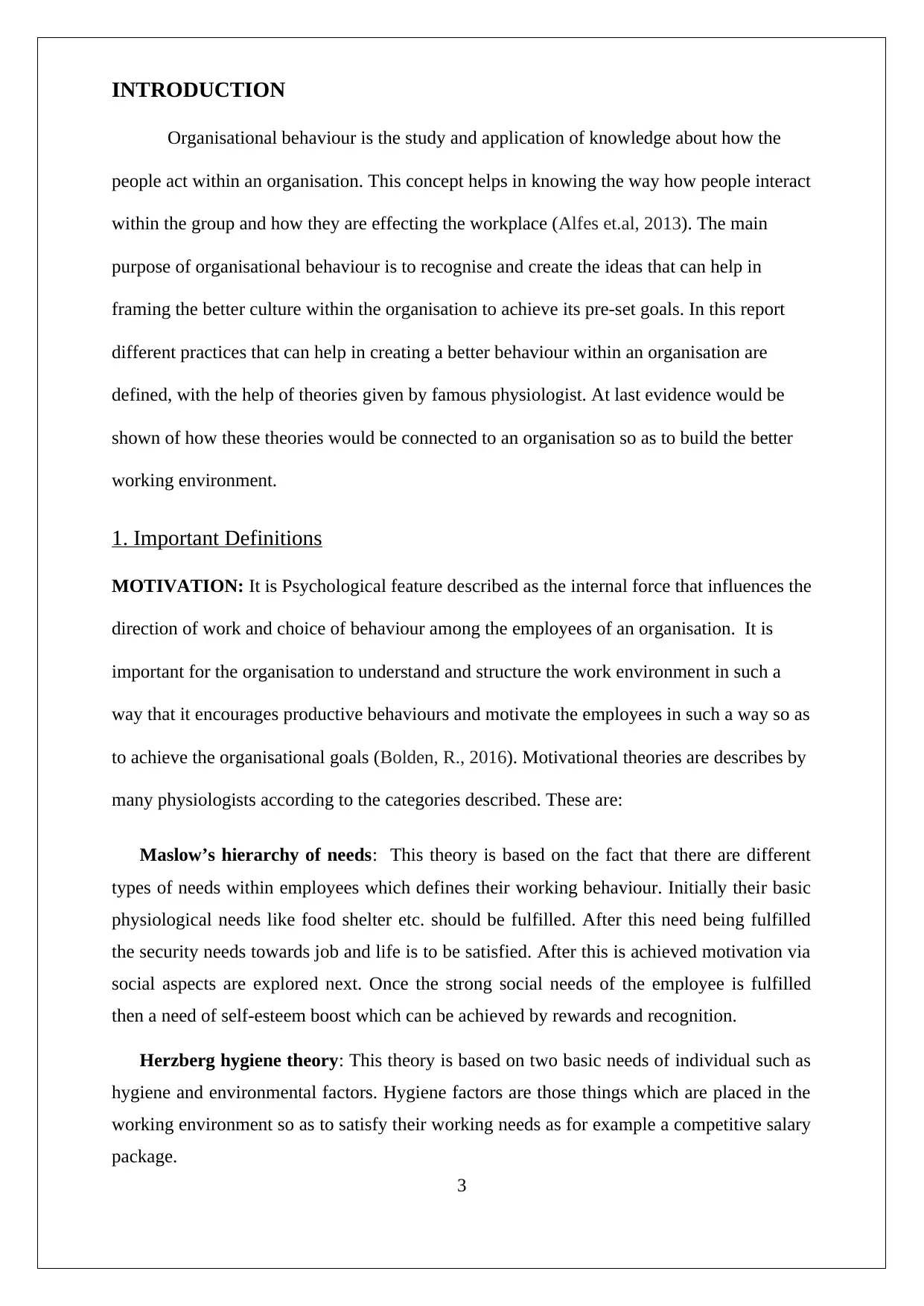
INTRODUCTION
Organisational behaviour is the study and application of knowledge about how the
people act within an organisation. This concept helps in knowing the way how people interact
within the group and how they are effecting the workplace (Alfes et.al, 2013). The main
purpose of organisational behaviour is to recognise and create the ideas that can help in
framing the better culture within the organisation to achieve its pre-set goals. In this report
different practices that can help in creating a better behaviour within an organisation are
defined, with the help of theories given by famous physiologist. At last evidence would be
shown of how these theories would be connected to an organisation so as to build the better
working environment.
1. Important Definitions
MOTIVATION: It is Psychological feature described as the internal force that influences the
direction of work and choice of behaviour among the employees of an organisation. It is
important for the organisation to understand and structure the work environment in such a
way that it encourages productive behaviours and motivate the employees in such a way so as
to achieve the organisational goals (Bolden, R., 2016). Motivational theories are describes by
many physiologists according to the categories described. These are:
Maslow’s hierarchy of needs: This theory is based on the fact that there are different
types of needs within employees which defines their working behaviour. Initially their basic
physiological needs like food shelter etc. should be fulfilled. After this need being fulfilled
the security needs towards job and life is to be satisfied. After this is achieved motivation via
social aspects are explored next. Once the strong social needs of the employee is fulfilled
then a need of self-esteem boost which can be achieved by rewards and recognition.
Herzberg hygiene theory: This theory is based on two basic needs of individual such as
hygiene and environmental factors. Hygiene factors are those things which are placed in the
working environment so as to satisfy their working needs as for example a competitive salary
package.
3
Organisational behaviour is the study and application of knowledge about how the
people act within an organisation. This concept helps in knowing the way how people interact
within the group and how they are effecting the workplace (Alfes et.al, 2013). The main
purpose of organisational behaviour is to recognise and create the ideas that can help in
framing the better culture within the organisation to achieve its pre-set goals. In this report
different practices that can help in creating a better behaviour within an organisation are
defined, with the help of theories given by famous physiologist. At last evidence would be
shown of how these theories would be connected to an organisation so as to build the better
working environment.
1. Important Definitions
MOTIVATION: It is Psychological feature described as the internal force that influences the
direction of work and choice of behaviour among the employees of an organisation. It is
important for the organisation to understand and structure the work environment in such a
way that it encourages productive behaviours and motivate the employees in such a way so as
to achieve the organisational goals (Bolden, R., 2016). Motivational theories are describes by
many physiologists according to the categories described. These are:
Maslow’s hierarchy of needs: This theory is based on the fact that there are different
types of needs within employees which defines their working behaviour. Initially their basic
physiological needs like food shelter etc. should be fulfilled. After this need being fulfilled
the security needs towards job and life is to be satisfied. After this is achieved motivation via
social aspects are explored next. Once the strong social needs of the employee is fulfilled
then a need of self-esteem boost which can be achieved by rewards and recognition.
Herzberg hygiene theory: This theory is based on two basic needs of individual such as
hygiene and environmental factors. Hygiene factors are those things which are placed in the
working environment so as to satisfy their working needs as for example a competitive salary
package.
3
⊘ This is a preview!⊘
Do you want full access?
Subscribe today to unlock all pages.

Trusted by 1+ million students worldwide
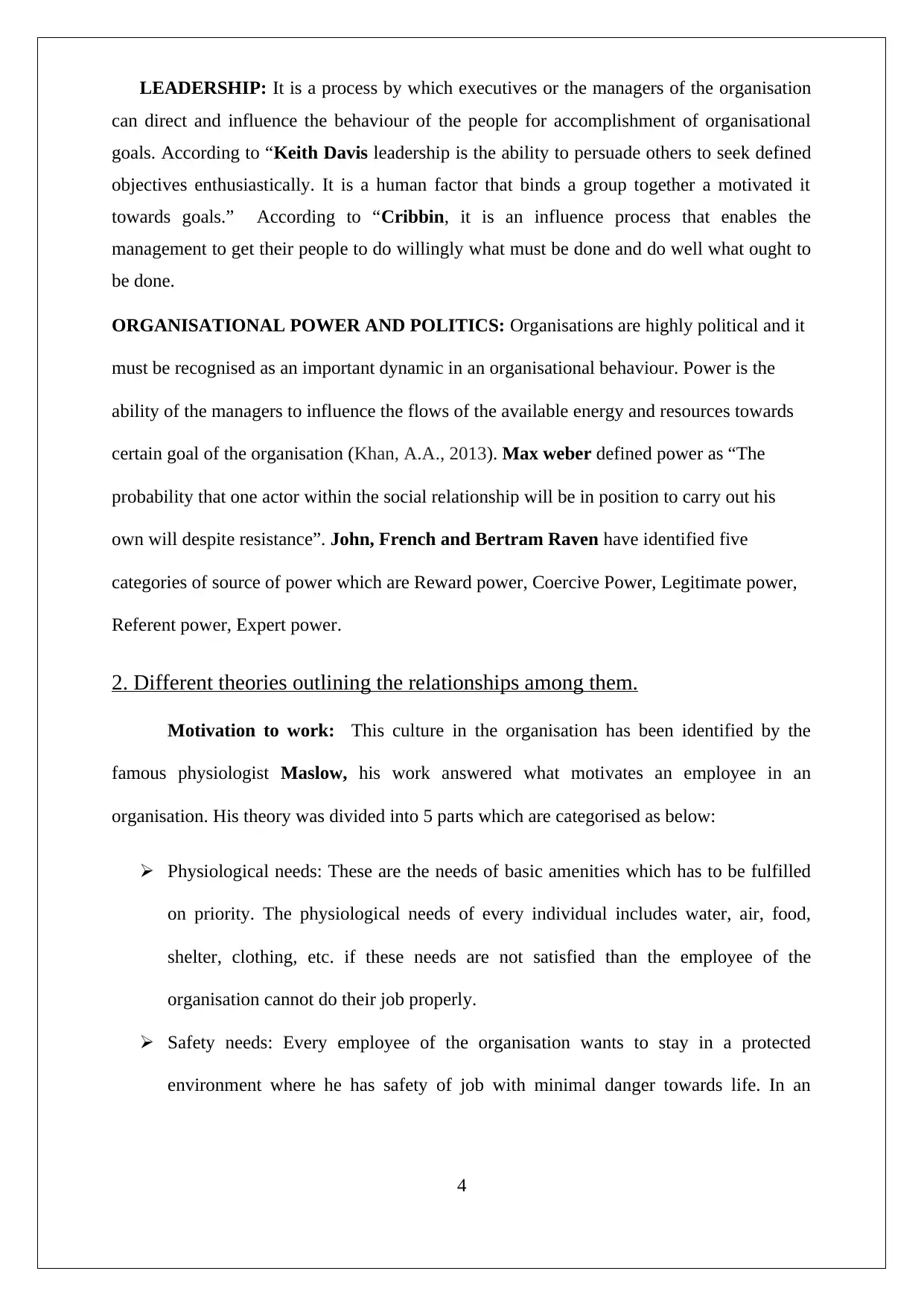
LEADERSHIP: It is a process by which executives or the managers of the organisation
can direct and influence the behaviour of the people for accomplishment of organisational
goals. According to “Keith Davis leadership is the ability to persuade others to seek defined
objectives enthusiastically. It is a human factor that binds a group together a motivated it
towards goals.” According to “Cribbin, it is an influence process that enables the
management to get their people to do willingly what must be done and do well what ought to
be done.
ORGANISATIONAL POWER AND POLITICS: Organisations are highly political and it
must be recognised as an important dynamic in an organisational behaviour. Power is the
ability of the managers to influence the flows of the available energy and resources towards
certain goal of the organisation (Khan, A.A., 2013). Max weber defined power as “The
probability that one actor within the social relationship will be in position to carry out his
own will despite resistance”. John, French and Bertram Raven have identified five
categories of source of power which are Reward power, Coercive Power, Legitimate power,
Referent power, Expert power.
2. Different theories outlining the relationships among them.
Motivation to work: This culture in the organisation has been identified by the
famous physiologist Maslow, his work answered what motivates an employee in an
organisation. His theory was divided into 5 parts which are categorised as below:
Physiological needs: These are the needs of basic amenities which has to be fulfilled
on priority. The physiological needs of every individual includes water, air, food,
shelter, clothing, etc. if these needs are not satisfied than the employee of the
organisation cannot do their job properly.
Safety needs: Every employee of the organisation wants to stay in a protected
environment where he has safety of job with minimal danger towards life. In an
4
can direct and influence the behaviour of the people for accomplishment of organisational
goals. According to “Keith Davis leadership is the ability to persuade others to seek defined
objectives enthusiastically. It is a human factor that binds a group together a motivated it
towards goals.” According to “Cribbin, it is an influence process that enables the
management to get their people to do willingly what must be done and do well what ought to
be done.
ORGANISATIONAL POWER AND POLITICS: Organisations are highly political and it
must be recognised as an important dynamic in an organisational behaviour. Power is the
ability of the managers to influence the flows of the available energy and resources towards
certain goal of the organisation (Khan, A.A., 2013). Max weber defined power as “The
probability that one actor within the social relationship will be in position to carry out his
own will despite resistance”. John, French and Bertram Raven have identified five
categories of source of power which are Reward power, Coercive Power, Legitimate power,
Referent power, Expert power.
2. Different theories outlining the relationships among them.
Motivation to work: This culture in the organisation has been identified by the
famous physiologist Maslow, his work answered what motivates an employee in an
organisation. His theory was divided into 5 parts which are categorised as below:
Physiological needs: These are the needs of basic amenities which has to be fulfilled
on priority. The physiological needs of every individual includes water, air, food,
shelter, clothing, etc. if these needs are not satisfied than the employee of the
organisation cannot do their job properly.
Safety needs: Every employee of the organisation wants to stay in a protected
environment where he has safety of job with minimal danger towards life. In an
4
Paraphrase This Document
Need a fresh take? Get an instant paraphrase of this document with our AI Paraphraser
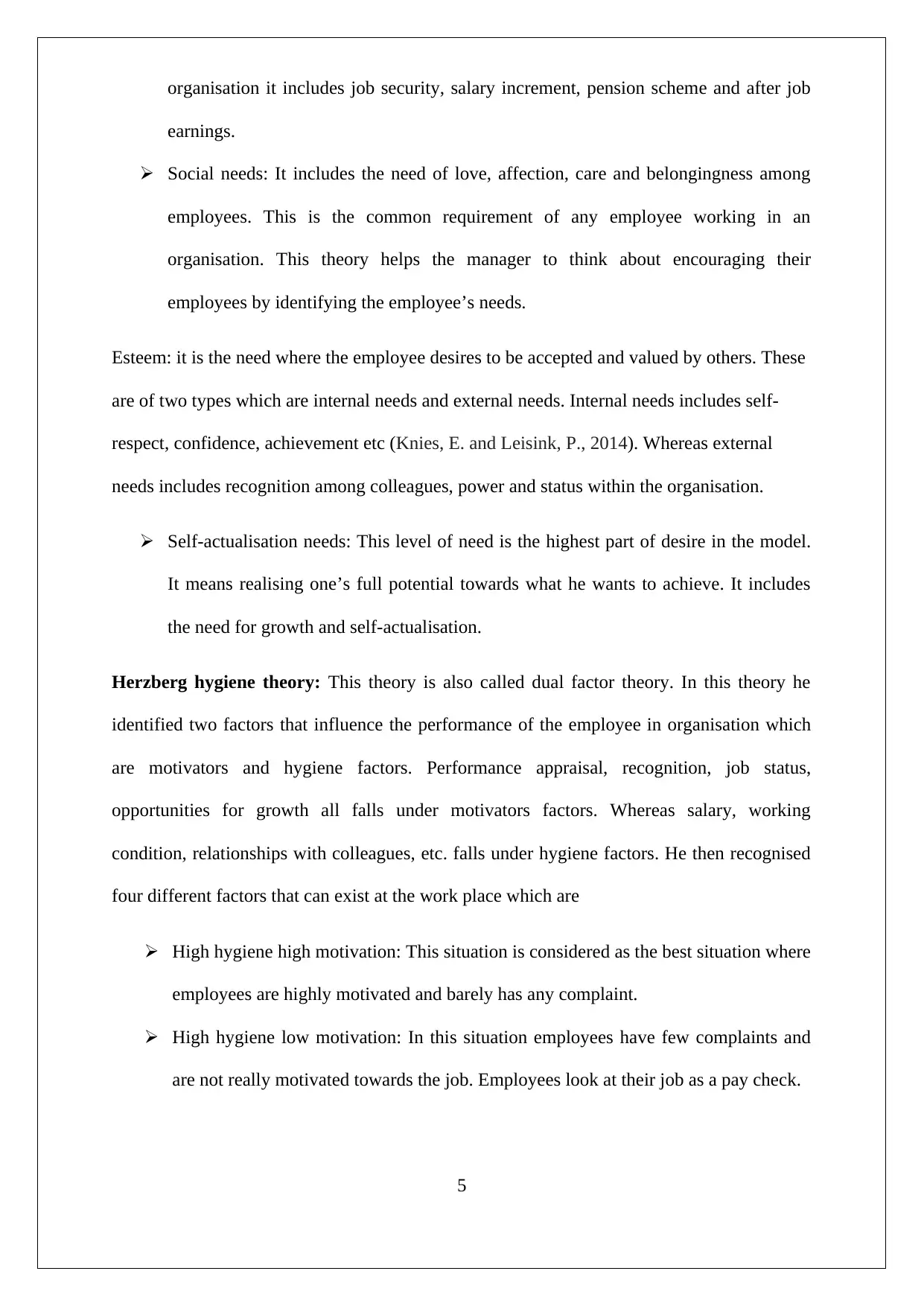
organisation it includes job security, salary increment, pension scheme and after job
earnings.
Social needs: It includes the need of love, affection, care and belongingness among
employees. This is the common requirement of any employee working in an
organisation. This theory helps the manager to think about encouraging their
employees by identifying the employee’s needs.
Esteem: it is the need where the employee desires to be accepted and valued by others. These
are of two types which are internal needs and external needs. Internal needs includes self-
respect, confidence, achievement etc (Knies, E. and Leisink, P., 2014). Whereas external
needs includes recognition among colleagues, power and status within the organisation.
Self-actualisation needs: This level of need is the highest part of desire in the model.
It means realising one’s full potential towards what he wants to achieve. It includes
the need for growth and self-actualisation.
Herzberg hygiene theory: This theory is also called dual factor theory. In this theory he
identified two factors that influence the performance of the employee in organisation which
are motivators and hygiene factors. Performance appraisal, recognition, job status,
opportunities for growth all falls under motivators factors. Whereas salary, working
condition, relationships with colleagues, etc. falls under hygiene factors. He then recognised
four different factors that can exist at the work place which are
High hygiene high motivation: This situation is considered as the best situation where
employees are highly motivated and barely has any complaint.
High hygiene low motivation: In this situation employees have few complaints and
are not really motivated towards the job. Employees look at their job as a pay check.
5
earnings.
Social needs: It includes the need of love, affection, care and belongingness among
employees. This is the common requirement of any employee working in an
organisation. This theory helps the manager to think about encouraging their
employees by identifying the employee’s needs.
Esteem: it is the need where the employee desires to be accepted and valued by others. These
are of two types which are internal needs and external needs. Internal needs includes self-
respect, confidence, achievement etc (Knies, E. and Leisink, P., 2014). Whereas external
needs includes recognition among colleagues, power and status within the organisation.
Self-actualisation needs: This level of need is the highest part of desire in the model.
It means realising one’s full potential towards what he wants to achieve. It includes
the need for growth and self-actualisation.
Herzberg hygiene theory: This theory is also called dual factor theory. In this theory he
identified two factors that influence the performance of the employee in organisation which
are motivators and hygiene factors. Performance appraisal, recognition, job status,
opportunities for growth all falls under motivators factors. Whereas salary, working
condition, relationships with colleagues, etc. falls under hygiene factors. He then recognised
four different factors that can exist at the work place which are
High hygiene high motivation: This situation is considered as the best situation where
employees are highly motivated and barely has any complaint.
High hygiene low motivation: In this situation employees have few complaints and
are not really motivated towards the job. Employees look at their job as a pay check.
5
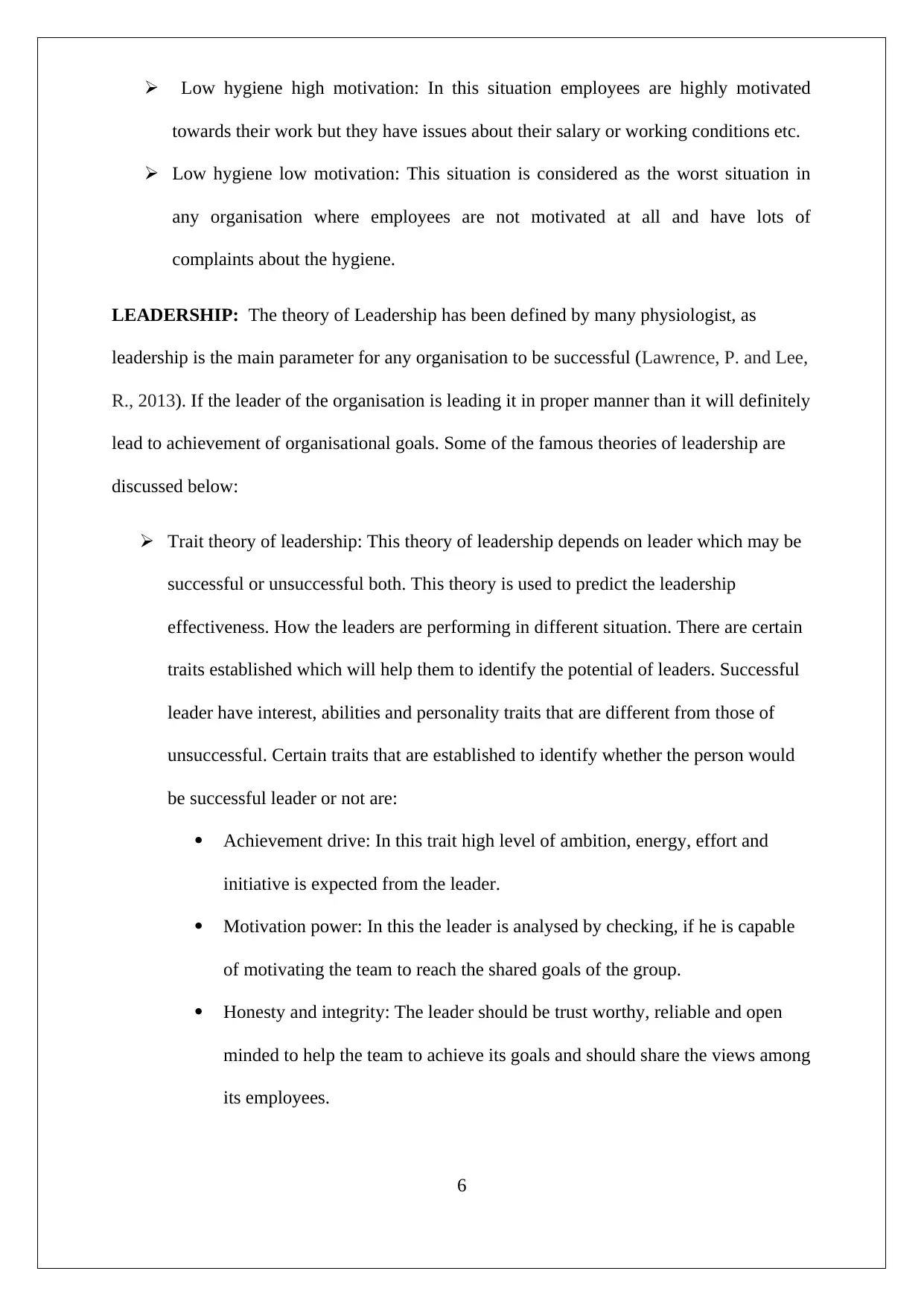
Low hygiene high motivation: In this situation employees are highly motivated
towards their work but they have issues about their salary or working conditions etc.
Low hygiene low motivation: This situation is considered as the worst situation in
any organisation where employees are not motivated at all and have lots of
complaints about the hygiene.
LEADERSHIP: The theory of Leadership has been defined by many physiologist, as
leadership is the main parameter for any organisation to be successful (Lawrence, P. and Lee,
R., 2013). If the leader of the organisation is leading it in proper manner than it will definitely
lead to achievement of organisational goals. Some of the famous theories of leadership are
discussed below:
Trait theory of leadership: This theory of leadership depends on leader which may be
successful or unsuccessful both. This theory is used to predict the leadership
effectiveness. How the leaders are performing in different situation. There are certain
traits established which will help them to identify the potential of leaders. Successful
leader have interest, abilities and personality traits that are different from those of
unsuccessful. Certain traits that are established to identify whether the person would
be successful leader or not are:
Achievement drive: In this trait high level of ambition, energy, effort and
initiative is expected from the leader.
Motivation power: In this the leader is analysed by checking, if he is capable
of motivating the team to reach the shared goals of the group.
Honesty and integrity: The leader should be trust worthy, reliable and open
minded to help the team to achieve its goals and should share the views among
its employees.
6
towards their work but they have issues about their salary or working conditions etc.
Low hygiene low motivation: This situation is considered as the worst situation in
any organisation where employees are not motivated at all and have lots of
complaints about the hygiene.
LEADERSHIP: The theory of Leadership has been defined by many physiologist, as
leadership is the main parameter for any organisation to be successful (Lawrence, P. and Lee,
R., 2013). If the leader of the organisation is leading it in proper manner than it will definitely
lead to achievement of organisational goals. Some of the famous theories of leadership are
discussed below:
Trait theory of leadership: This theory of leadership depends on leader which may be
successful or unsuccessful both. This theory is used to predict the leadership
effectiveness. How the leaders are performing in different situation. There are certain
traits established which will help them to identify the potential of leaders. Successful
leader have interest, abilities and personality traits that are different from those of
unsuccessful. Certain traits that are established to identify whether the person would
be successful leader or not are:
Achievement drive: In this trait high level of ambition, energy, effort and
initiative is expected from the leader.
Motivation power: In this the leader is analysed by checking, if he is capable
of motivating the team to reach the shared goals of the group.
Honesty and integrity: The leader should be trust worthy, reliable and open
minded to help the team to achieve its goals and should share the views among
its employees.
6
⊘ This is a preview!⊘
Do you want full access?
Subscribe today to unlock all pages.

Trusted by 1+ million students worldwide
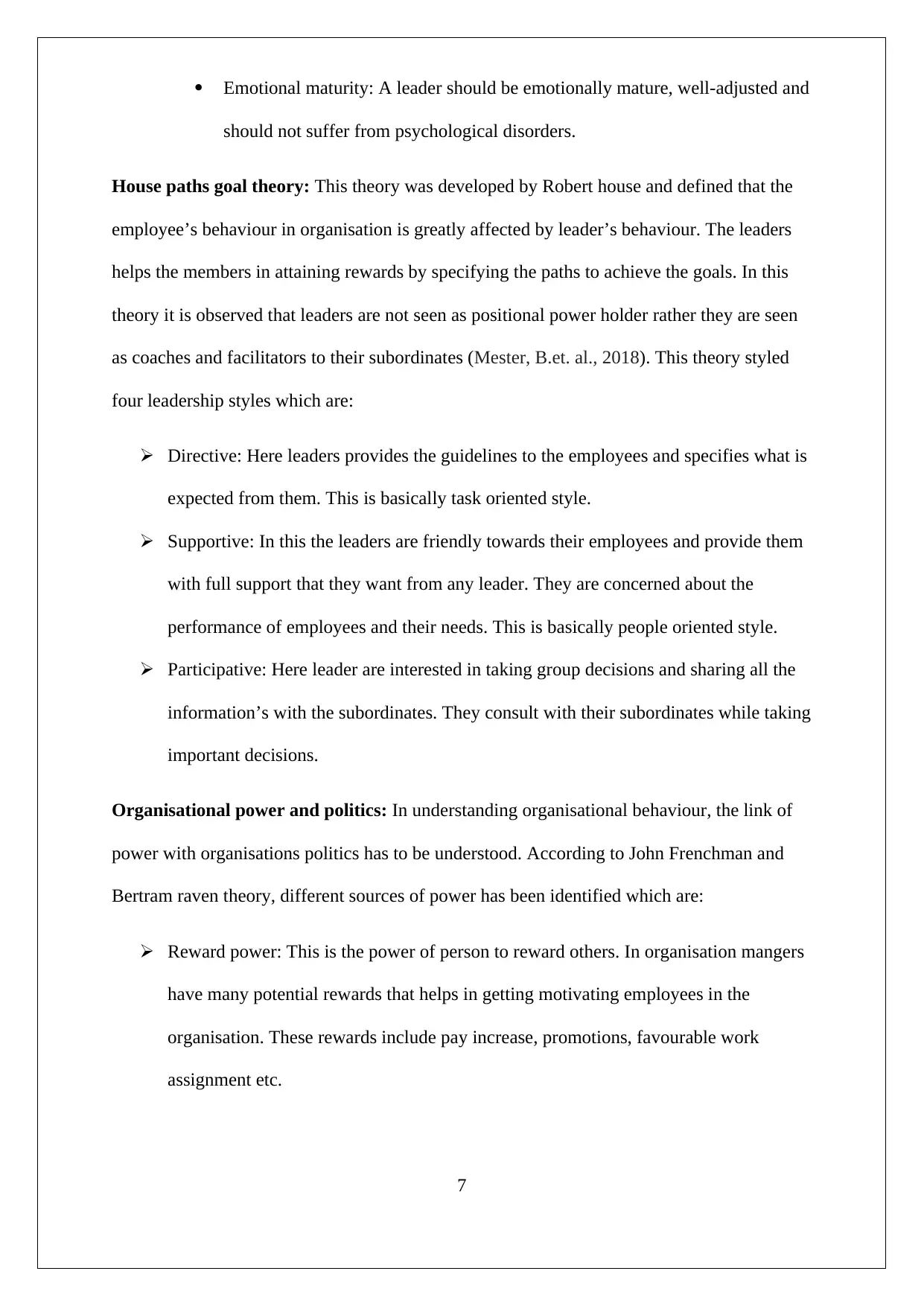
Emotional maturity: A leader should be emotionally mature, well-adjusted and
should not suffer from psychological disorders.
House paths goal theory: This theory was developed by Robert house and defined that the
employee’s behaviour in organisation is greatly affected by leader’s behaviour. The leaders
helps the members in attaining rewards by specifying the paths to achieve the goals. In this
theory it is observed that leaders are not seen as positional power holder rather they are seen
as coaches and facilitators to their subordinates (Mester, B.et. al., 2018). This theory styled
four leadership styles which are:
Directive: Here leaders provides the guidelines to the employees and specifies what is
expected from them. This is basically task oriented style.
Supportive: In this the leaders are friendly towards their employees and provide them
with full support that they want from any leader. They are concerned about the
performance of employees and their needs. This is basically people oriented style.
Participative: Here leader are interested in taking group decisions and sharing all the
information’s with the subordinates. They consult with their subordinates while taking
important decisions.
Organisational power and politics: In understanding organisational behaviour, the link of
power with organisations politics has to be understood. According to John Frenchman and
Bertram raven theory, different sources of power has been identified which are:
Reward power: This is the power of person to reward others. In organisation mangers
have many potential rewards that helps in getting motivating employees in the
organisation. These rewards include pay increase, promotions, favourable work
assignment etc.
7
should not suffer from psychological disorders.
House paths goal theory: This theory was developed by Robert house and defined that the
employee’s behaviour in organisation is greatly affected by leader’s behaviour. The leaders
helps the members in attaining rewards by specifying the paths to achieve the goals. In this
theory it is observed that leaders are not seen as positional power holder rather they are seen
as coaches and facilitators to their subordinates (Mester, B.et. al., 2018). This theory styled
four leadership styles which are:
Directive: Here leaders provides the guidelines to the employees and specifies what is
expected from them. This is basically task oriented style.
Supportive: In this the leaders are friendly towards their employees and provide them
with full support that they want from any leader. They are concerned about the
performance of employees and their needs. This is basically people oriented style.
Participative: Here leader are interested in taking group decisions and sharing all the
information’s with the subordinates. They consult with their subordinates while taking
important decisions.
Organisational power and politics: In understanding organisational behaviour, the link of
power with organisations politics has to be understood. According to John Frenchman and
Bertram raven theory, different sources of power has been identified which are:
Reward power: This is the power of person to reward others. In organisation mangers
have many potential rewards that helps in getting motivating employees in the
organisation. These rewards include pay increase, promotions, favourable work
assignment etc.
7
Paraphrase This Document
Need a fresh take? Get an instant paraphrase of this document with our AI Paraphraser
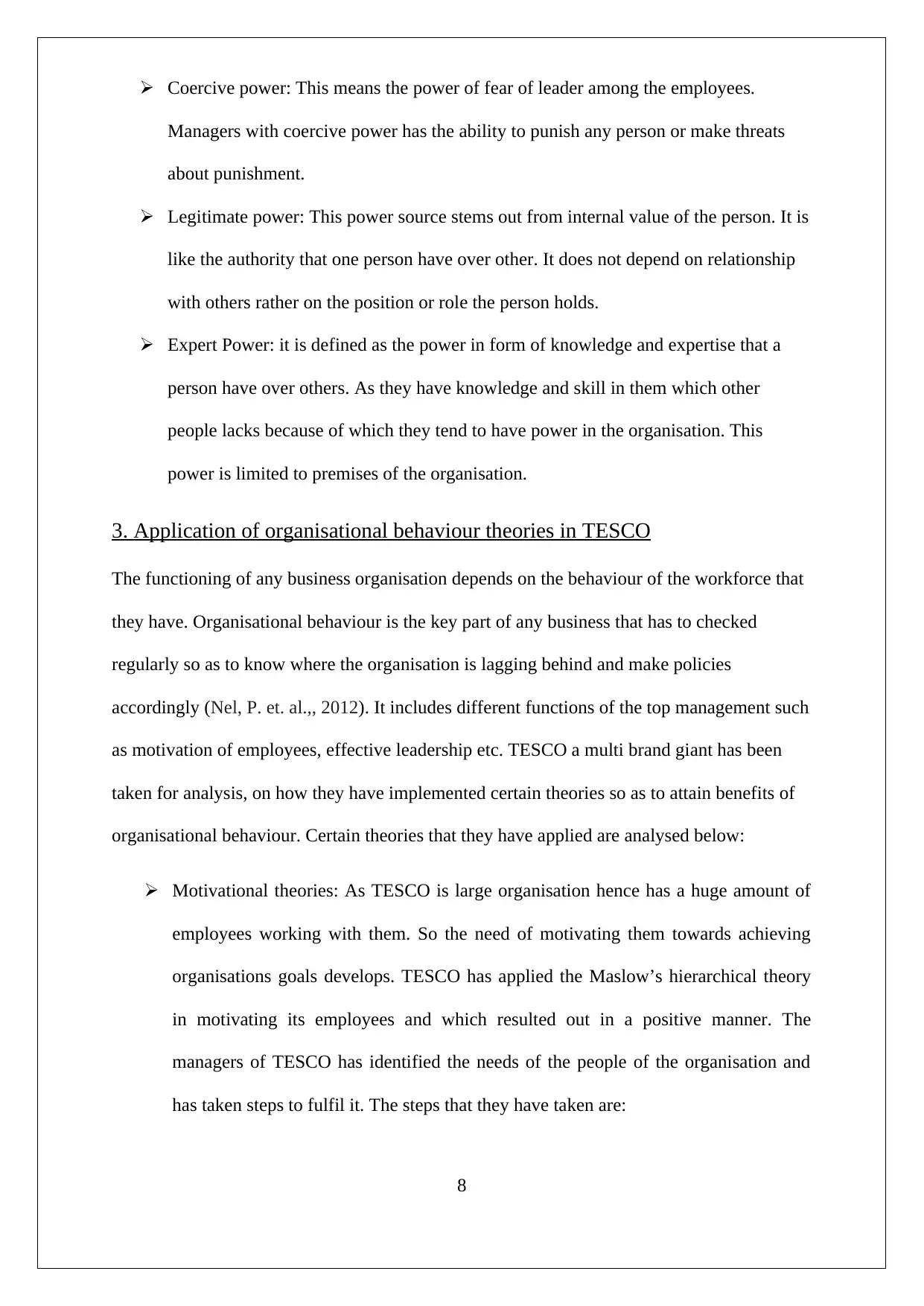
Coercive power: This means the power of fear of leader among the employees.
Managers with coercive power has the ability to punish any person or make threats
about punishment.
Legitimate power: This power source stems out from internal value of the person. It is
like the authority that one person have over other. It does not depend on relationship
with others rather on the position or role the person holds.
Expert Power: it is defined as the power in form of knowledge and expertise that a
person have over others. As they have knowledge and skill in them which other
people lacks because of which they tend to have power in the organisation. This
power is limited to premises of the organisation.
3. Application of organisational behaviour theories in TESCO
The functioning of any business organisation depends on the behaviour of the workforce that
they have. Organisational behaviour is the key part of any business that has to checked
regularly so as to know where the organisation is lagging behind and make policies
accordingly (Nel, P. et. al.,, 2012). It includes different functions of the top management such
as motivation of employees, effective leadership etc. TESCO a multi brand giant has been
taken for analysis, on how they have implemented certain theories so as to attain benefits of
organisational behaviour. Certain theories that they have applied are analysed below:
Motivational theories: As TESCO is large organisation hence has a huge amount of
employees working with them. So the need of motivating them towards achieving
organisations goals develops. TESCO has applied the Maslow’s hierarchical theory
in motivating its employees and which resulted out in a positive manner. The
managers of TESCO has identified the needs of the people of the organisation and
has taken steps to fulfil it. The steps that they have taken are:
8
Managers with coercive power has the ability to punish any person or make threats
about punishment.
Legitimate power: This power source stems out from internal value of the person. It is
like the authority that one person have over other. It does not depend on relationship
with others rather on the position or role the person holds.
Expert Power: it is defined as the power in form of knowledge and expertise that a
person have over others. As they have knowledge and skill in them which other
people lacks because of which they tend to have power in the organisation. This
power is limited to premises of the organisation.
3. Application of organisational behaviour theories in TESCO
The functioning of any business organisation depends on the behaviour of the workforce that
they have. Organisational behaviour is the key part of any business that has to checked
regularly so as to know where the organisation is lagging behind and make policies
accordingly (Nel, P. et. al.,, 2012). It includes different functions of the top management such
as motivation of employees, effective leadership etc. TESCO a multi brand giant has been
taken for analysis, on how they have implemented certain theories so as to attain benefits of
organisational behaviour. Certain theories that they have applied are analysed below:
Motivational theories: As TESCO is large organisation hence has a huge amount of
employees working with them. So the need of motivating them towards achieving
organisations goals develops. TESCO has applied the Maslow’s hierarchical theory
in motivating its employees and which resulted out in a positive manner. The
managers of TESCO has identified the needs of the people of the organisation and
has taken steps to fulfil it. The steps that they have taken are:
8
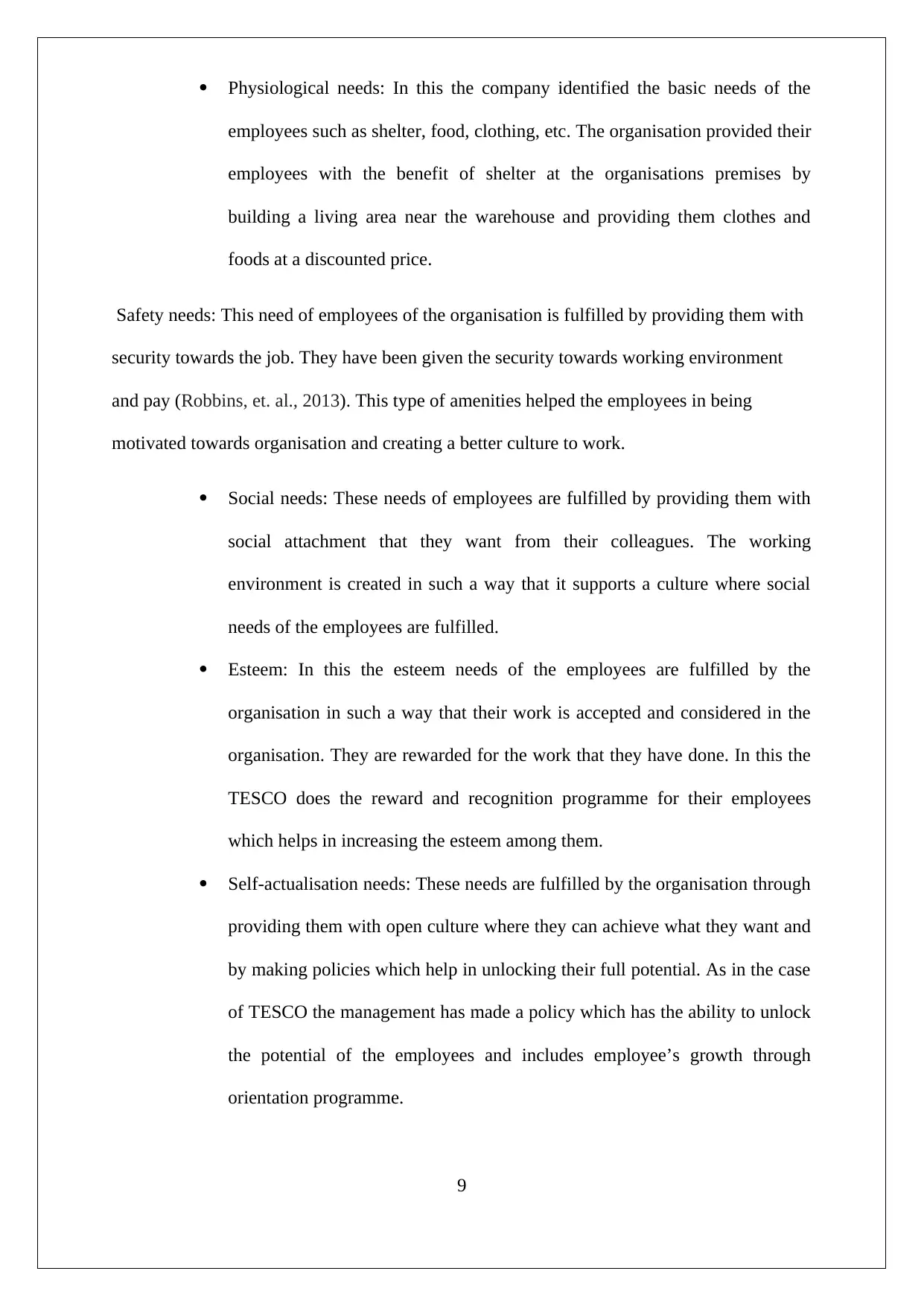
Physiological needs: In this the company identified the basic needs of the
employees such as shelter, food, clothing, etc. The organisation provided their
employees with the benefit of shelter at the organisations premises by
building a living area near the warehouse and providing them clothes and
foods at a discounted price.
Safety needs: This need of employees of the organisation is fulfilled by providing them with
security towards the job. They have been given the security towards working environment
and pay (Robbins, et. al., 2013). This type of amenities helped the employees in being
motivated towards organisation and creating a better culture to work.
Social needs: These needs of employees are fulfilled by providing them with
social attachment that they want from their colleagues. The working
environment is created in such a way that it supports a culture where social
needs of the employees are fulfilled.
Esteem: In this the esteem needs of the employees are fulfilled by the
organisation in such a way that their work is accepted and considered in the
organisation. They are rewarded for the work that they have done. In this the
TESCO does the reward and recognition programme for their employees
which helps in increasing the esteem among them.
Self-actualisation needs: These needs are fulfilled by the organisation through
providing them with open culture where they can achieve what they want and
by making policies which help in unlocking their full potential. As in the case
of TESCO the management has made a policy which has the ability to unlock
the potential of the employees and includes employee’s growth through
orientation programme.
9
employees such as shelter, food, clothing, etc. The organisation provided their
employees with the benefit of shelter at the organisations premises by
building a living area near the warehouse and providing them clothes and
foods at a discounted price.
Safety needs: This need of employees of the organisation is fulfilled by providing them with
security towards the job. They have been given the security towards working environment
and pay (Robbins, et. al., 2013). This type of amenities helped the employees in being
motivated towards organisation and creating a better culture to work.
Social needs: These needs of employees are fulfilled by providing them with
social attachment that they want from their colleagues. The working
environment is created in such a way that it supports a culture where social
needs of the employees are fulfilled.
Esteem: In this the esteem needs of the employees are fulfilled by the
organisation in such a way that their work is accepted and considered in the
organisation. They are rewarded for the work that they have done. In this the
TESCO does the reward and recognition programme for their employees
which helps in increasing the esteem among them.
Self-actualisation needs: These needs are fulfilled by the organisation through
providing them with open culture where they can achieve what they want and
by making policies which help in unlocking their full potential. As in the case
of TESCO the management has made a policy which has the ability to unlock
the potential of the employees and includes employee’s growth through
orientation programme.
9
⊘ This is a preview!⊘
Do you want full access?
Subscribe today to unlock all pages.

Trusted by 1+ million students worldwide
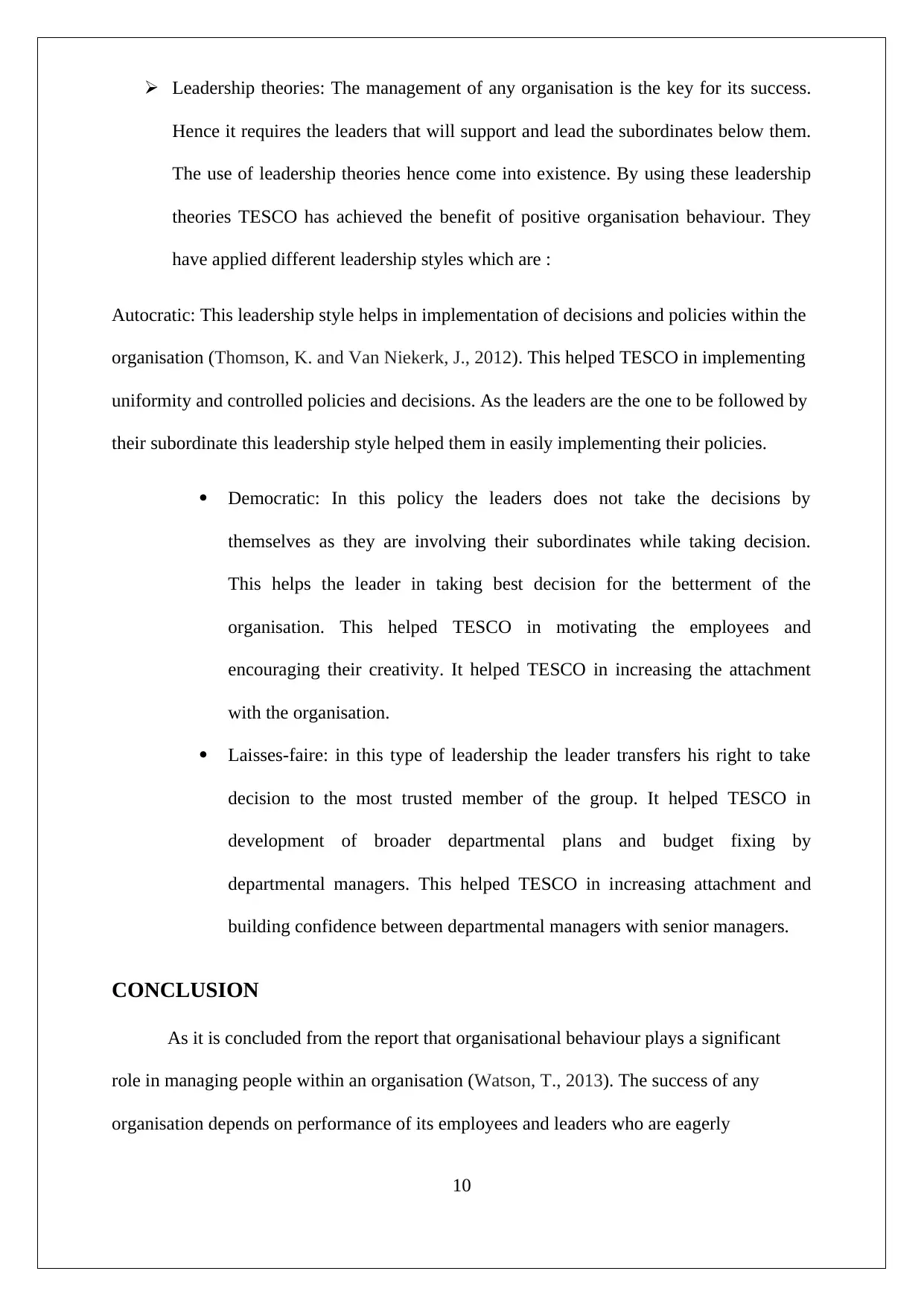
Leadership theories: The management of any organisation is the key for its success.
Hence it requires the leaders that will support and lead the subordinates below them.
The use of leadership theories hence come into existence. By using these leadership
theories TESCO has achieved the benefit of positive organisation behaviour. They
have applied different leadership styles which are :
Autocratic: This leadership style helps in implementation of decisions and policies within the
organisation (Thomson, K. and Van Niekerk, J., 2012). This helped TESCO in implementing
uniformity and controlled policies and decisions. As the leaders are the one to be followed by
their subordinate this leadership style helped them in easily implementing their policies.
Democratic: In this policy the leaders does not take the decisions by
themselves as they are involving their subordinates while taking decision.
This helps the leader in taking best decision for the betterment of the
organisation. This helped TESCO in motivating the employees and
encouraging their creativity. It helped TESCO in increasing the attachment
with the organisation.
Laisses-faire: in this type of leadership the leader transfers his right to take
decision to the most trusted member of the group. It helped TESCO in
development of broader departmental plans and budget fixing by
departmental managers. This helped TESCO in increasing attachment and
building confidence between departmental managers with senior managers.
CONCLUSION
As it is concluded from the report that organisational behaviour plays a significant
role in managing people within an organisation (Watson, T., 2013). The success of any
organisation depends on performance of its employees and leaders who are eagerly
10
Hence it requires the leaders that will support and lead the subordinates below them.
The use of leadership theories hence come into existence. By using these leadership
theories TESCO has achieved the benefit of positive organisation behaviour. They
have applied different leadership styles which are :
Autocratic: This leadership style helps in implementation of decisions and policies within the
organisation (Thomson, K. and Van Niekerk, J., 2012). This helped TESCO in implementing
uniformity and controlled policies and decisions. As the leaders are the one to be followed by
their subordinate this leadership style helped them in easily implementing their policies.
Democratic: In this policy the leaders does not take the decisions by
themselves as they are involving their subordinates while taking decision.
This helps the leader in taking best decision for the betterment of the
organisation. This helped TESCO in motivating the employees and
encouraging their creativity. It helped TESCO in increasing the attachment
with the organisation.
Laisses-faire: in this type of leadership the leader transfers his right to take
decision to the most trusted member of the group. It helped TESCO in
development of broader departmental plans and budget fixing by
departmental managers. This helped TESCO in increasing attachment and
building confidence between departmental managers with senior managers.
CONCLUSION
As it is concluded from the report that organisational behaviour plays a significant
role in managing people within an organisation (Watson, T., 2013). The success of any
organisation depends on performance of its employees and leaders who are eagerly
10
Paraphrase This Document
Need a fresh take? Get an instant paraphrase of this document with our AI Paraphraser

motivating them. The work that they will do jointly will result in success of the organisation.
As it has been seen in the report that TESCO has identified the motivational needs so as to
achieve its objective. The concept of motivation and leadership should be used together so
that they can contribute towards achieving the goals set by the organisation.
REFRENCES
BOOKS AND AUTHORS
Alfes et.al, 2013. The link between perceived human resource management practices,
engagement and employee behaviour: a moderated mediation model. The
international journal of human resource management. 24(2). Pp.330-351.
Binder, J., 2016. Global project management: communication, collaboration and
management across borders. Routledge.
Bolden, R., 2016. Leadership, management and organisational development. In Gower
handbook of leadership and management development (pp. 143-158). Routledge.
Khan, A.A., 2013. Human resource management and industrial relations. Abir Publication.
Knies, E. and Leisink, P., 2014. Linking people management and extra‐role behaviour: results
of a longitudinal study. Human Resource Management Journal. 24(1). Pp.57-76.
Lawrence, P. and Lee, R., 2013. Organizational Behaviour (RLE: Organizations): Politics at
Work. Routledge.
Mester, B.et. al., 2018. Performance management.
Nel, P. et. al.,, 2012. Human resource management in Australia and New Zealand.
Robbins, et. al., 2013. Organisational behaviour. Pearson Higher Education AU.
Thomson, K. and Van Niekerk, J., 2012. Combating information security apathy by
encouraging prosocial organisational behaviour. Information Management &
Computer Security. 20(1). Pp.39-46.
Watson, T., 2013. Management Organization and Employment Strategy (RLE:
Organizations): New Directions in Theory and Practice. Routledge.
11
As it has been seen in the report that TESCO has identified the motivational needs so as to
achieve its objective. The concept of motivation and leadership should be used together so
that they can contribute towards achieving the goals set by the organisation.
REFRENCES
BOOKS AND AUTHORS
Alfes et.al, 2013. The link between perceived human resource management practices,
engagement and employee behaviour: a moderated mediation model. The
international journal of human resource management. 24(2). Pp.330-351.
Binder, J., 2016. Global project management: communication, collaboration and
management across borders. Routledge.
Bolden, R., 2016. Leadership, management and organisational development. In Gower
handbook of leadership and management development (pp. 143-158). Routledge.
Khan, A.A., 2013. Human resource management and industrial relations. Abir Publication.
Knies, E. and Leisink, P., 2014. Linking people management and extra‐role behaviour: results
of a longitudinal study. Human Resource Management Journal. 24(1). Pp.57-76.
Lawrence, P. and Lee, R., 2013. Organizational Behaviour (RLE: Organizations): Politics at
Work. Routledge.
Mester, B.et. al., 2018. Performance management.
Nel, P. et. al.,, 2012. Human resource management in Australia and New Zealand.
Robbins, et. al., 2013. Organisational behaviour. Pearson Higher Education AU.
Thomson, K. and Van Niekerk, J., 2012. Combating information security apathy by
encouraging prosocial organisational behaviour. Information Management &
Computer Security. 20(1). Pp.39-46.
Watson, T., 2013. Management Organization and Employment Strategy (RLE:
Organizations): New Directions in Theory and Practice. Routledge.
11
1 out of 11
Related Documents
Your All-in-One AI-Powered Toolkit for Academic Success.
+13062052269
info@desklib.com
Available 24*7 on WhatsApp / Email
![[object Object]](/_next/static/media/star-bottom.7253800d.svg)
Unlock your academic potential
Copyright © 2020–2025 A2Z Services. All Rights Reserved. Developed and managed by ZUCOL.




